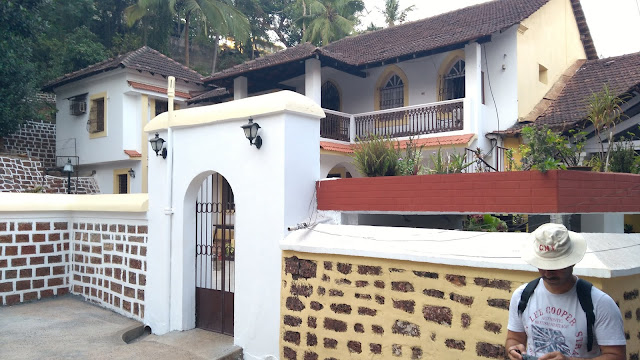As a child, it was always pure joy to open the pack of oil pastel crayons and feverishly fill up that colouring book. There were no rules of engagement, stems could be green and the leaves, brown; mangoes could be purple; snow - pink and houses - a mix of everything. Every colour was used liberally and to dramatic effect. Imagine then a neighbourhod whose houses and streets look like those childhood colouring books came to life - that's Fontainhas, the Latin quarter of Panjim.
Fontainhas is not a
difficult to access, unknown treasure. it's right at the heart of the state
capital, and has been written about extensively. But few want to consider Goa
as something more than a quick-fix party paradise. So Fontainhas continues to
take visitors by surprise!
And what a surprise
it is! While pink cities and blue cities abound, few historic town centres can
claim such lovely shades. The exuberance is infectious. You don't need a guide
to enjoy it. The first few times I visited were languid, late-afternoon strolls
through pedestrianised lanes. I would stop at every second house to admire just
how pretty it was, envious of those who lived there.
An insider's perspective
This time, I
discovered 'Make it happen', a company that organises heritage walks around
Goa, who helped me get an intimate look at Fontainhas.
We were met by
Alirio Da Costa, our sexagenarian guide, who was born and raised in the
neighbourhood, moved away for work, and now spends his retirement at his old
home. The connection he feels for the neighbourhood is immediately evident.
While he did speak about its history and the efforts being put in to maintain
it, his was a personal account of life and times in the area.
Alirio told of days
before there was a regular electric supply, when the neighbourhood was the edge
of town. He took us to his favourite neighbourhood bakery and also pointed out
the balcony where his childhood sweetheart used to stand.
His charming house
was our next stop. Situated right beside the St. Sebastian Chapel, the home is
vibrant like the rest of the neighbourhood and is packed with immaculately
maintained period furniture. Old books on local history, old paintings and ceramics, and Alirio's engaging conversational style, kept us glued.
Fontainhas is also
home to some lovely galleries and museums. We took a quick tour of the
Gitanjali gallery and the Fundação Oriente gallery… which besides their
collection, were also admittedly a welcome respite from the heat.
 |
| Alirio in his house |
Saving the best for
last, was a visit to Alirio's old friend (whose name I have sadly forgotten): a
musician whose relatively spartan, but beautiful house overlooked the Ourem
canal. As the sun set, he put us into a trance-like state of calm, playing old
Goan tunes on his guitar and singing in a low, melodious voice. Multiple
generations of Alirios and his friends have hummed these tunes, and their
stories: of children's games, family get-togethers, and young romance, have
added their own shades of colour to Fontainas' palette.
Heritage beyond Fontainhas
Fontainhas lies at
the base of a hill called Altinho, where the wealthy once lived. My favourite
way to access it… a colourful, tiled staircase, winding its way uphill beside
Alirio's house, and opening up at the High Court complex in Altinho (there are many
such staircases).
The Chief Minister's home, Archbishop's residence, Portuguese Consulate, and other stately homes with vistas of the River Mandovi, are all here.
The Chief Minister's home, Archbishop's residence, Portuguese Consulate, and other stately homes with vistas of the River Mandovi, are all here.
Make your way to the
riverfront and a structure called the 'Blue Building'. This is home to the
rather unique, 'Central Excise and Customs Museum'. I wasn't quite sure it was
open when I entered. Turns out I was only the fourth visitor for the day and the
staff was about the leave. The museum boasts information on the history of
customs and excise in the Indian sub-continent, the most infamous raids
conducted by Customs, and an eclectic assortment of articles recovered. A
member of staff accompanied me, turning lights and fans on and off wherever I
went and ensuring that I didn't linger very long (they were halfway out when I
went in, so understandable), but I'd definitely recommend a visit!
Azulejos: painted tiles
A common element in
Fontainhas are names of streets and homes on glazed and painted ceramic tiles.
These are called Azulejos, a technique nativ to Portugal and Spain, with
Arabic and Roman influences. The
Azulejos de Goa gallery is a great place to order your own such name plate.
But the grandest
display of Azulejos in Panjim, is not one that you can ask the gallery to
recreate. Feast your senses to the entrance hall of the Institute Menezes
Braganza. It's sure to take your breath away. You don't need permission to
enter, but be mindful of opening times.
I never fail to talk
about Fontainhas when someone mentions Goa nowadays. I'm sure I'll be back
there soon, taking in its therapeutic vibes. Until then, the memories serve me
well!










Comments
Post a Comment